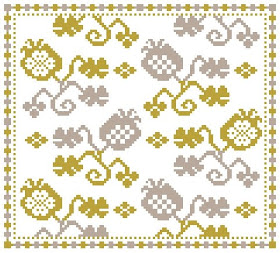
There is such a feast of wonderful items being auctioned in the next few weeks that it is a hard job to keep up with it all. We haven't looked at caps for a while and I thought our friends from the Netherlands might be interested to see this 18th century Dutch child's cap

What is special about this lot 141 are the painted, stamped metal motifs amongst the floral decoration in metal threads. It may have been custom made - or it may be a pieced cut down of some other garment. Its estimate is £200 - £300

This dainty early 17th century embroidered cap trimmed with metal lace is lot 281 for auction at Knowle on 20 April 2010 with an estimate of £3,000 - 4,000.

Flowers and scrolling foliage are worked in blue, pink, yellow and green silk threads on a linen ground, with gold coloured scrolling embroidery. It is wonderful to be able to see the stitching so close-up.

For auction on 21 April In Oxford, Lot 426 is an historic Grenadier Officer's embroidered mitre cap of around 1750, as worn by a member Of H.R.H. Prince George William Frederick's (later GIIIR) 'Boy' Regiment so called because it was formed for the amusement Prince George when a boy. The cap is embroidered in predominantly silver lace with coronet of a Royal Prince over a double 'G' cypher.

At the base is the white horse of Hanover worked as you can see in couched silver gilt thread. The front is stiffened with stout card and split cane, the reverse with whale bone strips. It is 26cm high with a bottom width of 22.5cm and its estimate is £4,000 - £6,000. But if the cap fits....
 In the 1680s Nicolas Arnout engraved a series of pictures of women and girls of quality, and just like you, these women of quality had a penchant for their stitching.
In the 1680s Nicolas Arnout engraved a series of pictures of women and girls of quality, and just like you, these women of quality had a penchant for their stitching. What sort of head covering do you wear when you stitch, I wonder?? Have a lovely weekend whether stitching or in the garden.
What sort of head covering do you wear when you stitch, I wonder?? Have a lovely weekend whether stitching or in the garden.















.jpg)
+copy.jpg)











.jpg)





















